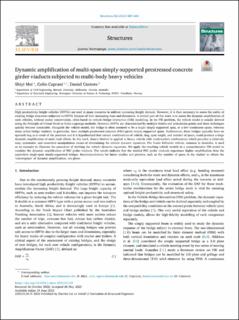| dc.description.abstract | High productivity freight vehicles (HPFVs) are used in many countries to address increasing freight demand. However, it is then necessary to assess the safety of existing bridge structures subjected to HPFVs because of their increasing mass and dimension. A critical part of this work is to assess the dynamic amplification of such vehicles, without undue conservatism, often based on vehicle–bridge interaction (VBI) modelling. In the VBI problem, the vehicle model is usually derived using the Principle of Virtual Work or Euler–Lagrange methods. However, HPFVs are characterized by multiple bodies and articulation points and these techniques quickly become intractable. Alongside the vehicle model, the bridge is often assumed to be a single simply-supported span, or a few continuous spans, whereas many urban bridge viaducts, in particular, have multiple prestressed concrete (PSC) girder simply-supported spans. Furthermore, these bridges typically have an upwards hog as a result of the prestress and it is hypothesized that certain combinations of vehicle, hog, span length, and number of spans, could produce a large dynamic amplification of static load effects. In this work, Kane’s Method is applied to heavy vehicle with multi-trailers combinations which provides a relatively easy, systematic, and numerical manipulation means of determining the vehicle dynamic equations. The 9-axle B-Double vehicle, common in Australia, is used as an example to illustrate the procedure of deriving the vehicle dynamic equations. We apply the resulting vehicle models in a comprehensive VBI model to consider the dynamic amplification of PSC girder viaducts. The results indicate that the studied PSC girder viaducts experience higher amplification than the equivalent single-span simply-supported bridges. Recommendations for future studies and practice, such as the number of spans in the viaduct to obtain the ‘convergence’ of dynamic amplification, are given. | en_US |
